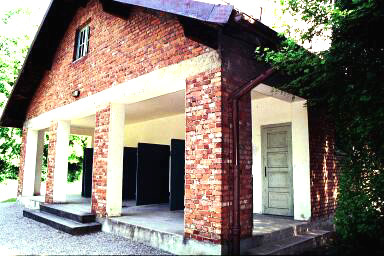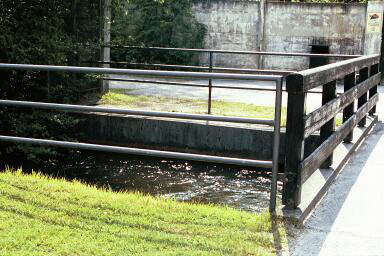New Crematorium at Dachau
The photograph below shows the south end of the new crematorium
building, called Baracke X, which was completed in 1943. The
wide gray doors that you see in the photograph are the doors
into the four disinfection gas chambers where the camp clothing
was deloused. The American soldiers in the 45th Thunderbird division
of the US Seventh Army, who participated in the liberation of
the camp on April 29, 1945, approached the concentration camp
from the west side and came upon the crematoria area before they
reached the gate into the prison compound. They saw these disinfection
gas chambers and assumed that they were used as homicidal gas
chambers for killing people. A line of clothes on hangers was
strung between the posts. The soldiers thought that the prisoners
had been forced to undress and hang up their clothes
before being shoved through these doors to be gassed.

South end of Baracke X with doors to disinfection
chambers
The photograph below, taken from behind the building, shows
the north end of Baracke X. This door leads to a room next to
the oven room. The soldiers of the 42nd Rainbow Division, who
also participated in the liberation, were given a guided tour
by the inmates after the camp was surrendered. They were told
that gas chambers in this building were routinely used to murder
prisoners in the camp. In the photograph, you can see branches
of a beautiful chestnut tree which stands behind the new crematorium.
There is a bench under this tree where one can rest in the shade
and contemplate the nearby mass grave of thousands of unknown
victims of the Dachau concentration camp. A restroom is through
a door on this side of the crematorium. Another restroom is at
the other end of the building in the hallway where the doors
open into the disinfection gas chambers.

North end of Baracke X photographed from the back
side
The area where the new crematorium building is located is
outside the prison compound on the west side of the camp at the
north end. This area is isolated from the prisoners' barracks
by the swift-flowing Würm river, which runs in a straight
line a few feet in front of the west wall of the prison compound.
The photograph directly below shows a small bridge across
the Würm river which runs through a concrete-lined canal.
This bridge is located at the present-day tourist entrance to
the area where the new crematorium is located. Behind the bridge,
you can see the west wall around the prison compound. The path
in front of the wall leads south to the gatehouse, where there
is an iron gate that is locked.

Bridge over the Würm river at the tourist entrance
to the crematoria

|


